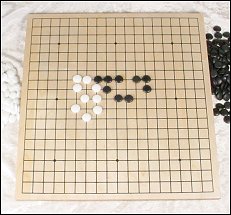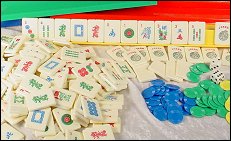
PLEASE NOTE: This is an archive of our original site, for informational purposes only. We no-longer have a sales catalogue.

A History of Board Games: When Did Game-Playing Start?One can well imagine that games have been played throughout human history, beginning as soon as there was a moment of leisure time not devoted to survival -- and as soon as communications between individuals got beyond the basics of conveying elementary needs and movement, into the realm of intention and ideas. It's a fact that games are played between babies and their parents from the first months of life, beginning with peek-a-boo and pat-a-cake and working up to hide-and-seek just as soon as a toddler is mobile. Games seem to be part of our nature, probably because they serve a useful purpose (learning skills like strategic thinking) all the while being fun. The broadest definition of games has to begin with such simple baby entertainments (which note: serve to exercise the infant mind in understanding that things that vanish aren't necessarily gone -- and exercise a body and develop coordination and rhythm) and extend through sports to strategy games of all sorts, and even include the games of "make believe" played by friends and siblings in the back yard on nice summer days -- which mature into modern role-playing games that combine elements of imagination with those of luck (roll of the dice) and strategy and rules. But here we concentrate on board games, which are defined as any game played primarily on, but sometimes just near, a board of some kind.
|
This history of board games is a work in progress, with new sections on ancient games added over time. |
|
The Earliest Board GamesThe oldest complete board game found thus far is "The Royal Game of Ur" -- which was discovered in 1926-1927 by Sir Leonard Woolley in royal tombs in what is now Iraq -- dating back to more than 2500 B.C.E. The ruins are of the city-state of Ur which once housed Abraham, so we can imagine that this game may have been played by people whose tales are told in the Bible. Among the wonders found within the tombs were four boards of the same basic design representing one game that was played by many classes of people in that society -- ranging from simple to richly worked pieces. It's not known whether UR was the first board game ever played but it's ancient enough that everything before it is pretty much guess-work. |
 A modern reproduction of the Royal Game of UR |
|
| The mancala family of games -- in which stones are moved about holes arranged in two (or more) parallel rows on a board -- probably originated with seeds or beans played in holes scooped in the dirt (an extremely easy-to-make game for farmers on a lunch break) -- which then evolved into a board game -- about the time folks got tired of scratching holes in the dirt. There are so many variations of mancala that it has to have been around for thousands of years and, likely, goes back further. Rows of holes have been found carved on slabs in ancient structures in Egypt, even in the pyramid of Cheops, that look remarkably like mancala game boards. Saharan remains that date back 3000 years look like mancala boards, too. Richard Leakey found some boards with two rows of thirteen holes in Kenya, that he dates to Neolithic times. Some of these may be ancient calculators but undoubtedly some are early forms of the game. | 
Click for more information on Mancala, and rules for three varieties |
|
Ancient Games Begin In China: Wei-qi (Go)The Game of Go ("Wei-qi" in its original Chinese form) enjoys a special place in board game history, because not only is it one of the oldest games known, it has kept essentially the same rules for longer than any other board game out there. After its origins in China perhaps as far back as 2300 B.C.E., Wei-qi spread into Korea in the second century (where it was called Pa-tok, now Baduk or Badug), and finally, when it traveled to Japan via trade routes sometime around the year 700 A.D. -- it developed into a most sophisticated game unlike just about any other class of games -- and the rules have not varied significantly since that time. Because Go is really a game about capturing territory, it falls outside all the usual classifications of games: alignment games, war games, capture games, hunt games, race games -- though it has hints of some of these in it. Though capture is a part of Go, and it is often considered a war game, capture is just one aspect, and it is not so much about aspects of war (generals and soldiers and war equipment) as it is about defining who owns what spaces on the board. The pieces have no differing powers at all -- they simply serve to mark the borders of territory. |

Click for more detail on the Game of Go, including enough of the rules to give a feel for the game |
|
Another Chinese Game: Mah JonggMah Jongg is said to have originated in the Tang Dynasty in China -- about 4000 years ago. Whether its original form was paper (cards) and it later moved onto tiles, or whether it began as tiles (or wooden planks) and cards later developed from it, most of the length of its early history has been recorded as being limited to the aristocracy -- the rules were kept secret until China became a republic early in the last century! It is very likely that the earliest versions of the game would bear little resemblance to the game as played today. Only in 1920 did it step outside its country of origin and spread, first to the United States and then around the world. Strongly resembling the card game "Rummy" -- true Mah Jong is a game for four players (and bears little relation to the dull but mesmerizing solitaire version often found on computers, sometimes called "Shanghai"). |

|
|
Dice Games, Race GamesCertainly one of the oldest forms of gaming, in general, has to be "lots" played with dice. The earliest form of die seems to have been a binary -- quite often using the small end of a branch of a tree, cut in half so that when thrown it ended either round or flat side up (as seen in the game of Senet; see below). The interesting thing about binary dice is that the odds on a throw of the more extreme numbers (one or six) are very different than they would be using the modern, traditional, six-sided die. With a six-sider you have an equal chance of rolling any number (one in six). But using five of the stick-dice to get six different result (one flat, two flat, three flat, four flat, five flat and no flat would equal six) there are so many different ways of coming up with a 2 or a 3 (ten different ways each), and a fair number of ways to come up with a one or a four (five ways each) but only one way of coming up with a five or a six (all flat up or all flat down) -- which is why in ancient games based on binary dice you'll often see the very rare throws greatly rewarded, with extra distance on moves and a free throw, too. Dice were later made out of bones and were called "astragals" -- usually made from the knuckle bones of sheep or goats which, when rolled on a hard, flat surface, would land in one of four ways -- customarily valued at 1, 3, 4 and 6. These would certainly have been used for gambling, and it is not a long step from the throwing of dice to the need for some way to keep score -- which is likely where the earliest of race games came from. The simplest race games are just that -- a board with spaces and a marker to move along it, and dice to tell you how far to move. Such a game may entertain a child for a little while but one quickly realizes there is no skill at all involved (except perhaps in the throwing of the dice) and no strategy. The next introduction to race games would have been helps and hazards (as with Snakes and Ladders) themed in a way appropriate to whatever game you're playing. Still not a very challenging game though. Adding more complications makes the game more interesting, so next we allow the players more than one piece -- so they can choose which to move -- and the ability to bump each other off the board. Add a few "safe" spots and keep the other hazards and helps and we now have a game suitable for adults. |
||
The Ancient Egyptian Game of SenetOne such very early game is S'n't -- lately known as "Senet" or "Senat". This very early board game was found in many ancient Egyptian tombs -- both of pharaohs and workers. A magnificent board was found buried with Tutankhamen. In this game of 30 squares set in three rows of 10, both player's pieces enter the board at one end of a row, proceed to the end, turn and go back down the middle at the end of which they turn again, drop to the final row and go back -- the object being to bear off all your pieces before your opponent does. Special spots on the board represent death and being turned away from the afterlife -- and rebirth to try again. The heiroglyph representing a Senet game is found honoring a king -- and dates back to 3100 B.C.E. -- and if the game was known and respected then, it must be older still. |
The original hieroglyphics left out the vowels, so we have to guess at how we might pronounce the name of this game. Most sources fill the spaces with "e" to get "Senet" but another popular version has it as "Senat". They are equally valid. Some would call it "zinat."
|
|
| Copyright © 2003 Astral Castle, All Rights Reserved Worldwide. | Page added November 30, 2003. Last updated: January 07, 2009 |
Sources and Links: